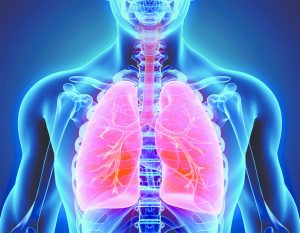 Big news in the realm of lung cancer treatment: Low Dose Computed Tomography, or LDCT, can dramatically reduce the chance of lung cancer death among heavy smokers. The landmark finding is the result of a randomized clinical trial of more than 53,000 current and former heavy tobacco smokers ages 55 – 74. In the trial, sponsored by the National Cancer Institute, participants were given either a standard chest x-ray or LDCT annually for three years. Those who received LDCT had superior discovery of nodules in the lung while they were still small and contained enough to be medically treated, resulting in 20% fewer lung cancer deaths than those who received conventional chest x-rays. Loosely applied, this translates to one out of five lung cancer victims’ lives being saved through early discovery using this advanced diagnostic scan.
Big news in the realm of lung cancer treatment: Low Dose Computed Tomography, or LDCT, can dramatically reduce the chance of lung cancer death among heavy smokers. The landmark finding is the result of a randomized clinical trial of more than 53,000 current and former heavy tobacco smokers ages 55 – 74. In the trial, sponsored by the National Cancer Institute, participants were given either a standard chest x-ray or LDCT annually for three years. Those who received LDCT had superior discovery of nodules in the lung while they were still small and contained enough to be medically treated, resulting in 20% fewer lung cancer deaths than those who received conventional chest x-rays. Loosely applied, this translates to one out of five lung cancer victims’ lives being saved through early discovery using this advanced diagnostic scan.
“This is monumental,” says RAO Board Certified radiologist Mark Yap, MD. “From our own empirical evidence, we have often recommended LDCT for early discovery of lung cancer among longtime smokers. To have such a large clinical trial support our independent thesis is validating.”
Lung cancer is the most deadly cancer in the US and worldwide, and approximately 85% of its sufferers are current and former heavy smokers, those who have reached 30 “pack years.” A pack year is calculated by: number of packs a day x number of years spent smoking. For example, someone smoking one pack a day for 30 years or two packs a day for 15 years has reached the 30-pack-year threshold. Former smokers who hit this benchmark are still considered at high risk until they have been smoke-free for 15 years. “The lungs begin to heal very quickly once a person stops smoking, so quitting is still the best preventive measure there is,” says Dr. Yap. “But longtime smokers often have so much lung damage it takes many years for their lungs to heal completely, and often cancer is already present. Cessation of smoking can limit cancer growth, and in many former smokers the nodules are so small only low-dose CT is capable of capturing them.”
Early discovery is important because once symptoms of lung cancer appear (chronic dry, phlegmy or bloody cough, wheezing, weight loss), it most often signifies the spread of cancer outside the lung, where it is challenging – and too-often impossible – to treat. Discovering anomalies in the lung before they cause symptoms is critical in catching lung cancer while it is still treatable.
Low-dose computed tomography is a non-invasive diagnostic scan that provides a nearly 3-D view of the chest and lungs with up to 90% less ionizing radiation than conventional CT. “RAO’s Medical Imaging Center will feature the most advanced LDCT technology available. It is capable of detecting the tiniest abnormality in the lungs that other technologies can miss,” adds Board Certified radiologist Ralf Barckhausen, MD.
Based on the findings of the clinical trial, the American Cancer Society, the American Lung Association, the National Comprehensive Cancer Network and other influential medical bodies now recommend that high-risk individuals consider annual LDCT screening. People ages 55-77 with a 30-pack-year history and a qualified medical professional’s written order for LDCT are eligible to have their scans covered by Medicare.
Current and former heavy smokers are encouraged to talk to their doctors about whether LDCT might be a healthcare measure to consider. “And if you have tried and tried to quit smoking, don’t count yourself out yet,” says Dr. Barckhausen. “Very often the next time is the last time, so keep the faith and
keep trying. It’s worth it.
For more information, contact your primary care physician to find out if this screening exam is right for you.
Radiology Associates
352-671-4300 . www.RAOcala.com
Tags featured
Check Also
CUSTOMIZABLE LIGHT ADJUSTABLE LENS A GAMECHANGER FOR CATARACTS PATIENTS
All Americans have some degree of cataract change by the age of 75. As the …
 Central Florida Health and Wellness Magazine Health and Wellness Articles of the Villages
Central Florida Health and Wellness Magazine Health and Wellness Articles of the Villages



